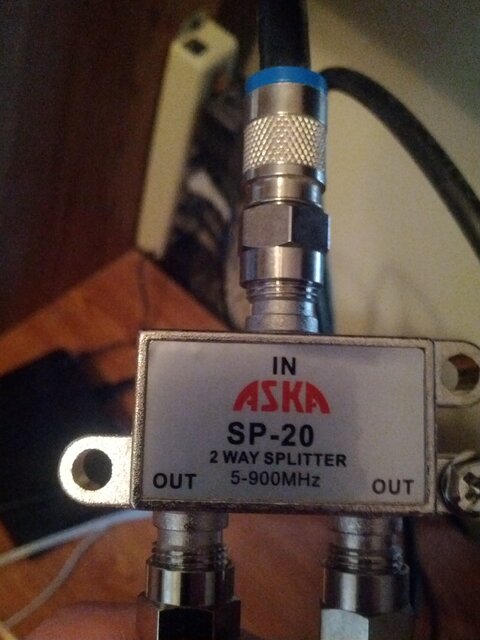DouNodes are a doozy!
- Thread starter cjlee89
- Start date
- Latest activity Latest activity:
- Replies 49
- Views 7K
You are using an out of date browser. It may not display this or other websites correctly.
You should upgrade or use an alternative browser.
You should upgrade or use an alternative browser.
Yep! Thats how the sticker is on our node (H,C,C,H).Host are the outside. Client the inside.
Once we re-wire and double check the connections at the LNB, whats the next step if it doesn't work?
do you really have two taps? or one tap and one splitter?
if you really have two taps, then all the cabling past the node needs to be 3Ghz rated RG6.
Looks to me like Tap 1 is mislabeled and should be a splitter in your diagram, but you'll have to confirm.
if you really have two taps, then all the cabling past the node needs to be 3Ghz rated RG6.
Looks to me like Tap 1 is mislabeled and should be a splitter in your diagram, but you'll have to confirm.
Pictures of Taps 1 and 2.
right... Tap 1 should actually be Splitter 1 in your diagram. basically you have 1 tap and 1 splitter in your system.
I will change nowright... Tap 1 should actually be Splitter 1 in your diagram
EDIT: Updated in original post. Attached here for reference.
Attachments
Nodes and taps just have a thin silicone doughnut inside the connection barrel. Very easy to miss the center conductor socket. Check each connection's coax for a bent center conductor. Had to remove and reinstall one of the rubber seals on my dual node causing a bad connection.
Im pretty sure he checked the LNB connections on the dish. Ill be ticked if they didn't do a complete dish to node to hoppers walk through. Also, cabling is new from dish to node.
Almost done with the diagram.
Did you try lifting the ground wire off the DuoNode yet? I had exactly the same issue. All of the LNBs checked out fine, the signal strength was good on the meter, but after connecting to the DuoNode, one of my Hoppers would not complete a download. When checking the cables at the receiver, the installer said it looked like there was a short or bad LNB. Once the ground was lifted, the signal came up and after reconnecting, the Hopper downloaded its software in about 16 minutes.
We currently have a single node hooked up. I will suggest this Monday evening when they come back. So lift the ground to get things going 100% and then re-attach it? I should mention the ground looks to be going up towards the dish...Did you try lifting the ground wire off the DuoNode yet? I had exactly the same issue. All of the LNBs checked out fine, the signal strength was good on the meter, but after connecting to the DuoNode, one of my Hoppers would not complete a download. When checking the cables at the receiver, the installer said it looked like there was a short or bad LNB. Once the ground was lifted, the signal came up and after reconnecting, the Hopper downloaded its software in about 16 minutes.
They probably did, but did they check the satellite signal with a meter on ALL 3 cables? I've peaked a dish once or twice then discovered a line off the dish was bad. You could experiment with this yourself by removing one of your inputs from your current single node, putting the third line where that line was and running a check switch on the hopper.
Yes, he said he checked all three lines and verified the dish hit all 3 satellites (110, 119, 129).They probably did, but did they check the satellite signal with a meter on ALL 3 cables? I've peaked a dish once or twice then discovered a line off the dish was bad. You could experiment with this yourself by removing one of your inputs from your current single node, putting the third line where that line was and running a check switch on the hopper.
Where should the ground be going? Up towards the dish (which doesn't seem like a ground to me if its connected to the dish) or somewhere else?
click through some of the pictures here... you'll see how a lot of installers are grounding:
http://www.satelliteguys.us/hopper-zone/280664-post-your-dish-hopper-pictures-layout.html
http://www.satelliteguys.us/hopper-zone/280664-post-your-dish-hopper-pictures-layout.html
Seems like the node was never grounded in the first place. The wire that is attached to the RG6 is attached but nothing to ground anything.click through some of the pictures here... you'll see how a lot of installers are grounding:
http://www.satelliteguys.us/hopper-zone/280664-post-your-dish-hopper-pictures-layout.html
All splitters have to be power passing, also we have had bad lnbs with tuner 2 being bad. do a check switch then select details and look at each tuner
Mine did the same thing.. It is the duo node.. I replaced it and all was good.. I think there is a bad batch of these out there..
This sounds much like a job I had to recently go fix. 3 different contractors could not get the 2nd hopper working. Eventually I ended up crawling through a small crawl space in their basement to find out that a diplexer had been left in the line they were using for the host line. If a host line runs through a diplexer it is going to cap off a segment of the frequencies that the hopper is receiving it can cause the hopper to inconsistently work and be unable to see any joey's that are on the opposite side of the diplexer. If the installers used preexisting cables. I would recommend fully tracing the lines. If unable to trace the line, run a host line on ground from node to hopper to test with what would now be a guaranteed straight line.



